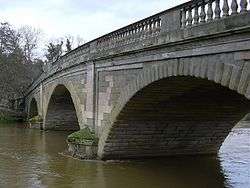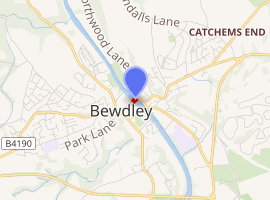Bewdley Bridge
Bewdley Bridge is a three-span masonry arch bridge over the River Severn at Bewdley, Worcestershire, designed by civil engineer Thomas Telford.[1]. The two side spans are each 52 feet (16 m), with the central span 60 feet (18 m). The central arch rises 18 feet (5.5 m). Smaller flood arches on the bank bridge the towpath. The bridge is 27 feet (8.2 m) wide.
Bewdley Bridge | |
|---|---|
 Bewdley Bridge from Severnside North | |
| Coordinates | 52°22′35″N 2°18′50″W |
| Carries | Motor vehicles, B4190 road |
| Crosses | River Severn |
| Locale | Bewdley, Worcestershire |
| Heritage status | Grade I listed |
| Characteristics | |
| Design | Arch bridge |
| Material | stone |
| Width | 27 feet (8.2 m) |
| Longest span | 60 feet (18 m) |
| No. of spans | 3 |
| Piers in water | 2 |
| Clearance below | 18 feet (5.5 m) |
| History | |
| Designer | Thomas Telford |
| Constructed by | John Simpson |
| Construction end | 1798 |

| |
History
There has been a bridge at this location since 1447, each being destroyed and replaced.[2] Severe flooding in 1795 destroyed the previous bridge. That bridge comprised five pointed stone arches. A stone gatehouse on one pier had been replaced with a stone cottage by the time of a 1781 print. One of the arches had also been damaged by the Royalists in 1644 and rebuilt in timber.[3]
Parts of a fifteenth-century bridge were rediscovered in 2004 during excavations for new flood defences.[4]
Thomas Telford designed the current bridge and was assisted by resident civil engineer, M Davidson.[1] It was built in 1798 by Shrewsbury-based contractor John Simpson for £9,000.[5] Its toll house was demolished in the 1960s.
The bridge was one of the main objectives of Oliver Cromwell, during the Battle of Worcester. Colonel Robert Lilburne, along with Major Mercer, 5 troops of Worcester Dragoons[6], Worcestershire horse and 2 troops of Colonel Rich's regiment[7] were assigned to secure the bridge during the Battle.
See also
- Crossings of the River Severn
References
- Glover, Julien (2017). Man of Iron - Thomas Telford and the Building of Britain. London: Bloomsbury. p. 363.
- Buteux, Victoria (1995), Archaeological assessment of Bewdley (and Wribbenhall), Hereford and Worcester (PDF), Worcestershire County Archaeological Service, retrieved 24 January 2010
- Jervoise, E. (1976) [1936]. Ancient Bridges of Wales & Western England. EP Publishing. p. 142. ISBN 0-7158-1152-5.
- "Workmen discover old town bridge". BBC News. 2 September 2004. Retrieved 24 January 2010.
- "Bewdley Bridge". Engineering Timelines. Archived from the original on 10 July 2011. Retrieved 24 January 2010.
- Stace, Machell (1810). Cromwelliana: A Chronological Detail of Events in which Oliver Cromwell was Engaged; from the Year 1642 to His Death, 1658: with a Continuation of Other Transactions to the Restoration. M. Stace.
- Baldock, Thomas Stanford (1809). Cromwell as a Soldier. K. Paul, Trench, Trübner & Company, Limited.
Further reading
- Cragg, R., Civil Engineering Heritage - Wales & West Central England, Thomas Telford Publishing, 2nd edn., 1997, ISBN 0-7277-2576-9
- Witts, C., A Century of Bridges, River Severn Publications, 2nd edn., 1998, ISBN 0-9532711-0-2